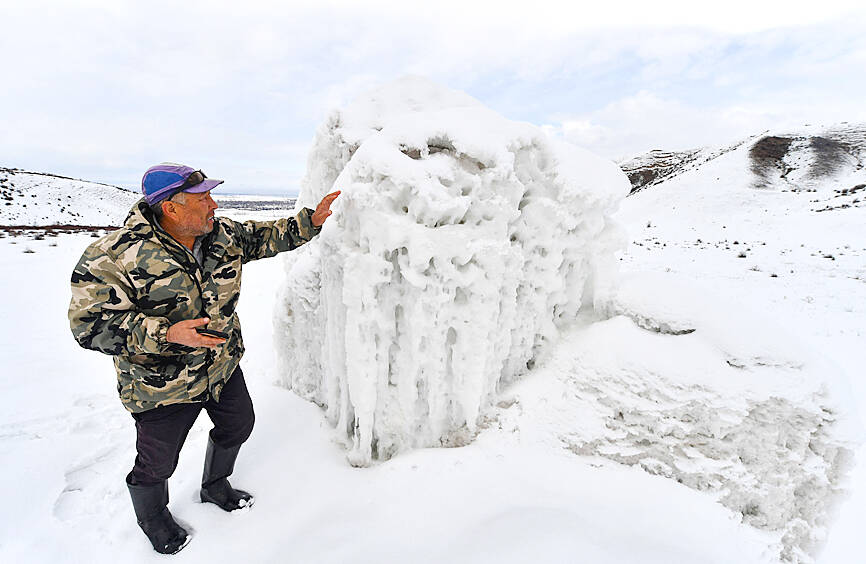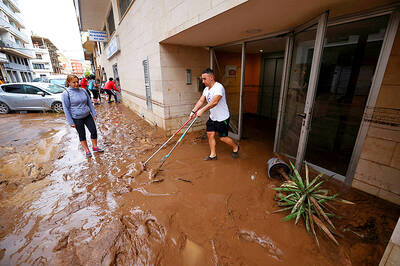In the Tian-Shan mountains of Kyrgyzstan, villagers have made an artificial glacier to provide water for their drought-hit farms.
Standing on the ice hillock, farmer Erkinbek Kaldanov said he was optimistic about harnessing nature to counteract climate change.
“We won’t have any more problems with water,” said the farmer, who was worried for his sheep last year after some unusual temperature spikes.

Photo: AFP
“When the glacier melts, there will be enough water for the livestock and to water the land in Syn-Tash,” the surrounding district, he said.
The glacier is 5m tall and about 20m long. At the height of winter it was 12m tall.
Residents made it over two weeks in autumn by redirecting water from the peaks of Tian-Shan, which tower more than 4,000m high in northern Kyrgyzstan.
Kaldanov and others are being forced to adapt since natural glaciers in Central Asia — the main water source for the region — are slowly disappearing due to global warming.
A study in the journal Science last year predicted that the acceleration in the melting of the glaciers would peak only between 2035 and 2055.
The lack of snow, also due to higher temperatures, does not allow them to regenerate.
The extent of the problem can be seen in satellite images of Central Asia and in the regular warnings issued by the UN. It has a knock-on effect on the lowlands of Central Asia, in more arid countries like Kazakhstan, Turkmenistan and Uzbekistan.
This in turn feeds into existing tensions between the different countries, which still share water resources under a complex and obsolete scheme inherited from the Soviet era.
“There is less and less water every year. The water tables are emptying out, the springs are drying up and we have problems with grazing,” said Aidos Yzmanaliyev, a spokesman for the Syn-Tash farmers.
Finding solutions is urgent, particularly as farming represents about 10 percent of the fragile Kyrgyz economy and two-thirds of its inhabitants live in rural areas.
In the north of Kyrgyzstan, a country accustomed to revolutions and uprisings, the lack of water has already stoked social tensions in previous periods of drought.
“Our main aim is to provide water for livestock since the majority of the 8,400 inhabitants of the Syn-Tash district are farmers,” district chief Maksat Dzholdoshev said.
“We expect to create two or three additional artificial glaciers for farmland,” he said.
The idea and its implementation are relatively simple. Each glacier costs about 550,000 som (US$6,152) to create.
“The water comes from a mountain source 3km away through underground piping. It gushes out and freezes, forming a glacier,” Yzmanaliyev said.
Apart from providing water when it melts, the glacier also helps lower the ambient temperature and create humidity.
That “helps the surrounding vegetation, which is grazed by cattle from spring to autumn,” Yzmanaliyev said.
Artificial glaciers were first created in the Indian Himalayas in 2014 and have gone global — cropping up in Chile and Switzerland.
In Kyrgyzstan, their introduction was spearheaded by Abdilmalik Egemberdiyev, head of the National Pasture Users’ Association of Kyrgyzstan.
Egemberdiyev pointed to an additional benefit.
The glaciers allow farmers to keep livestock on spring pastures for longer before sending them to summer pastures, thus slowing soil erosion.
“We now have 24 artificial glaciers around the country and more still to be created,” he said.

STEPPING UP: Diminished US polar science presence mean opportunities for the UK and other countries, although China or Russia might also fill that gap, a researcher said The UK’s flagship polar research vessel is to head to Antarctica next week to help advance dozens of climate change-linked science projects, as Western nations spearhead studies there while the US withdraws. The RRS Sir David Attenborough, a state-of-the-art ship named after the renowned British naturalist, would aid research on everything from “hunting underwater tsunamis” to tracking glacier melt and whale populations. Operated by the British Antarctic Survey (BAS), the country’s polar research institute, the 15,000-tonne icebreaker — boasting a helipad, and various laboratories and gadgetry — is pivotal to the UK’s efforts to assess climate change’s impact there. “The saying goes

Floods on Sunday trapped people in vehicles and homes in Spain as torrential rain drenched the northeastern Catalonia region, a day after downpours unleashed travel chaos on the Mediterranean island of Ibiza. Local media shared videos of roaring torrents of brown water tearing through streets and submerging vehicles. National weather agency AEMET decreed the highest red alert in the province of Tarragona, warning of 180mm of rain in 12 hours in the Ebro River delta. Catalan fire service spokesman Oriol Corbella told reporters people had been caught by surprise, with people trapped “inside vehicles, in buildings, on ground floors.” Santa Barbara Mayor Josep Lluis

Police in China detained dozens of pastors of one of its largest underground churches over the weekend, a church spokesperson and relatives said, in the biggest crackdown on Christians since 2018. The detentions, which come amid renewed China-US tensions after Beijing dramatically expanded rare earth export controls last week, drew condemnation from US Secretary of State Marco Rubio, who on Sunday called for the immediate release of the pastors. Pastor Jin Mingri (金明日), founder of Zion Church, an unofficial “house church” not sanctioned by the Chinese government, was detained at his home in the southern city of Beihai on Friday evening, said

SANCTIONS: Congolese Minister of Foreign Affairs Therese Kayikwamba Wagner called on the EU to tighten sanctions against Rwanda during an event in Brussels The Democratic Republic of the Congo (DR Congo) has accused the EU of “an obvious double standard” for maintaining a minerals deal with Rwanda to supply Europe’s high-tech industries when it deployed a far-wider sanctions regime in response to the war in Ukraine. Congolese Minister of Foreign Affairs Therese Kayikwamba Wagner urged the EU to levy much stronger sanctions against Rwanda, which has fueled the conflict in the eastern DR Congo, describing the bloc’s response to breaches of the DR Congo’s territory as “very timid.” Referencing the EU’s response to Russia’s invasion of Ukraine, she said: “It is an obvious double standard